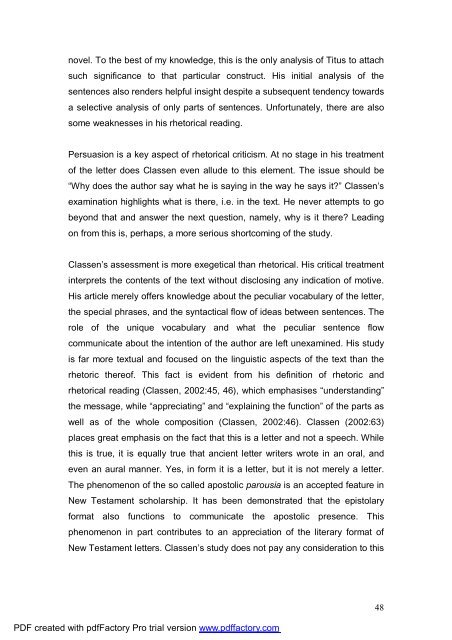A Text centred rhetorical analysis of Paul's Letter to Titus
A Text centred rhetorical analysis of Paul's Letter to Titus
A Text centred rhetorical analysis of Paul's Letter to Titus
You also want an ePaper? Increase the reach of your titles
YUMPU automatically turns print PDFs into web optimized ePapers that Google loves.
novel. To the best <strong>of</strong> my knowledge, this is the only <strong>analysis</strong> <strong>of</strong> <strong>Titus</strong> <strong>to</strong> attach<br />
such significance <strong>to</strong> that particular construct. His initial <strong>analysis</strong> <strong>of</strong> the<br />
sentences also renders helpful insight despite a subsequent tendency <strong>to</strong>wards<br />
a selective <strong>analysis</strong> <strong>of</strong> only parts <strong>of</strong> sentences. Unfortunately, there are also<br />
some weaknesses in his <strong>rhe<strong>to</strong>rical</strong> reading.<br />
Persuasion is a key aspect <strong>of</strong> <strong>rhe<strong>to</strong>rical</strong> criticism. At no stage in his treatment<br />
<strong>of</strong> the letter does Classen even allude <strong>to</strong> this element. The issue should be<br />
“Why does the author say what he is saying in the way he says it?” Classen’s<br />
examination highlights what is there, i.e. in the text. He never attempts <strong>to</strong> go<br />
beyond that and answer the next question, namely, why is it there? Leading<br />
on from this is, perhaps, a more serious shortcoming <strong>of</strong> the study.<br />
Classen’s assessment is more exegetical than <strong>rhe<strong>to</strong>rical</strong>. His critical treatment<br />
interprets the contents <strong>of</strong> the text without disclosing any indication <strong>of</strong> motive.<br />
His article merely <strong>of</strong>fers knowledge about the peculiar vocabulary <strong>of</strong> the letter,<br />
the special phrases, and the syntactical flow <strong>of</strong> ideas between sentences. The<br />
role <strong>of</strong> the unique vocabulary and what the peculiar sentence flow<br />
communicate about the intention <strong>of</strong> the author are left unexamined. His study<br />
is far more textual and focused on the linguistic aspects <strong>of</strong> the text than the<br />
rhe<strong>to</strong>ric there<strong>of</strong>. This fact is evident from his definition <strong>of</strong> rhe<strong>to</strong>ric and<br />
<strong>rhe<strong>to</strong>rical</strong> reading (Classen, 2002:45, 46), which emphasises “understanding”<br />
the message, while “appreciating” and “explaining the function” <strong>of</strong> the parts as<br />
well as <strong>of</strong> the whole composition (Classen, 2002:46). Classen (2002:63)<br />
places great emphasis on the fact that this is a letter and not a speech. While<br />
this is true, it is equally true that ancient letter writers wrote in an oral, and<br />
even an aural manner. Yes, in form it is a letter, but it is not merely a letter.<br />
The phenomenon <strong>of</strong> the so called apos<strong>to</strong>lic parousia is an accepted feature in<br />
New Testament scholarship. It has been demonstrated that the epis<strong>to</strong>lary<br />
format also functions <strong>to</strong> communicate the apos<strong>to</strong>lic presence. This<br />
phenomenon in part contributes <strong>to</strong> an appreciation <strong>of</strong> the literary format <strong>of</strong><br />
New Testament letters. Classen’s study does not pay any consideration <strong>to</strong> this<br />
PDF created with pdfFac<strong>to</strong>ry Pro trial version www.pdffac<strong>to</strong>ry.com<br />
48

















